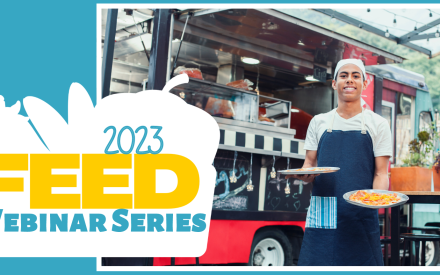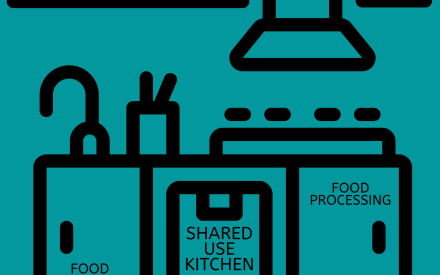First, we want to acknowledge the challenges that our families, communities and businesses are going through due to COVID-19. We hope you, your family, and your community are healthy and safe.
This resource guide is designed to help licensed Wisconsin food cart and food truck vendors implement best practices in safety, identify new business opportunities, and utilize resources, such as grants, loans and childcare support. Given this ever changing situation, please note that there may be additional resources and recommendations available going forward. As you go through the information below, please do not hesitate to reach out with questions, concerns, ideas, or suggestions.
If you are not a licensed food cart or food truck vendor and you are interested in starting a food cart or food truck, please contact your local health department or the Department of Agriculture, Trade and Consumer Protection for information on licensing requirements. State and/or local regulatory authorities must be contacted and approvals with permits must be granted before food carts and food trucks may operate in Wisconsin.
Quick links:
Wisconsin Vending Regulations
Child Care
Health and Safety Recommendations
New Business Opportunities and Delivery Guidelines
Loans, Grants and Additional Resources
Print the PDF of the complete guide.
Print the PDF of the complete guide en Espanol.
COVID-19 HEALTH & SAFETY INFORMATION
The State of Wisconsin, including the Department of Agriculture, Trade and Consumer Protection (DATCP), continues to monitor the spread of COVID-19 in coordination with the Department of Health Services (DHS), Public Health and other local, state, and federal partners.
You can access information from multiple state agencies at Wisconsin.gov/COVID19. As circumstances continue to evolve, this webpage will be continually updated.
If you have questions, please contact your local county health department.
COVID-19 LICENSED FOOD CART & TRUCK VENDING REGULATIONS
Licensed mobile food operators may vend out of their food cart, food truck or base/commissary kitchen. Please consult with the city/town/village(s) regarding where you do business to confirm the current rules on parking, portable signs (sandwich boards), and other requirements regarding operating in the right-of-way. Also be aware of crowd and social distancing rules in place under Special Order #12.
Emergency Order #12, Essential Services & Operations, pg 10-11
- Gov. Evers Emergency Order 12: Safer at Home Order
- Orden de Emergencia 12: Orden Mas Seguro en Casa
- Ntawv Xaj Xwm Ceev # 12 Ntawv Xaj Kom Nyob Hauv Tsev Rau Qhov Nyab Xeeeb Dua
Licensed Food Cart & Food Truck Vendor Requirements
Licenses must be active and in good standing. Vendors must abide by all currently applicable safe food practices. These rules include:
- Only take-out, counter order or delivery service may be provided.
- No seating may be provided on premises, indoors or outdoors.
- Food and drink may not be consumed on the premises, either indoors or outdoors
- Self-service operations of salad bars, beverage stations, and buffets are prohibited.
- Customers are prohibited from self-dispensing any unpackaged food or beverage.
- Carryout sales of alcohol beverages are allowed if permitted by state law and municipal ordinance.
- Delivery of alcoholic beverages to retail customers is prohibited.
Source: Gov Evers Safer at Home Order FAQs
Child Care
Emergency Order #12 (pg.11) defines food cart and food truck vendors as tier two essential workers.
Tier one takes priority over tier two, as defined below:
Tier One: employees, contractors, and other support staff working in health care
Tier Two: employees, contractors, and other staff in vital areas including but not limited to military; long term care; residential care; pharmacies; child care; child welfare; government operations; public safety and critical infrastructure such as sanitation, transportation, utilities, telecommunications; grocery and food services; supply chain operations; and other sectors as determined by the department.
If you need child care in order to run your business, please visit this site for more information about availability, affordability and the safety of the child care provided:
Wisconsin Department of Children and Families COVID-19 Child Care Resources.
Health and Safety
- Schedule staffing density to levels that allow a minimum of six feet of distance between all employees at all times. This includes both in the kitchen and in the mobile unit.
- If an employee is symptomatic, do not allow them to come in to work. If they arrive at work send them home immediately (be aware of and use current sick leave and sick pay provisions). Disinfect all areas that person came into contact with.
- If your operation has a sick leave policy that involves the accrual of hours, ignore the accrual and offer full sick leave benefits even to new employees under current emergency provisions. Currently, the contagion period after symptoms disappear is not known. According to the Wisconsin Department of Health Services, any employee who has been positively diagnosed with COVID-19, or has shown symptoms should stay at home until:
- That employee is free of fever (>100.4°F) AND/OR respiratory symptoms (for example, cough, shortness of breath) for at least three days (72 hours) without the use of fever-reducing medicine; AND
- Seven days have passed since symptoms first appeared.
Source: WI Department of Health Services: When can a recovering COVID-19 patient return to work?
Additional resources
Food Industry Recommended Protocols When Employee/Visitor/Customer Tests Positive for COVID-19
- Hold meetings remotely when possible. If in-person meetings are necessary, keep attendance at a bare minimum and hold the meetings sitting at least six feet apart from one another. Here are a few free web-based remote meeting and conferencing options:
- FaceTime group call (for iPhone, iPad, iTouch)
- Zoom
- GoTo Meeting
- ezTalks
- Skype
- Create systems for contact-free exchange of necessary documents, food, and equipment. Rather than passing equipment or food to each other, one employee will set it on a table, step away, and allow the other to come pick it up. Pay checks and other documents are laid out on a table for employees to walk up to, one at a time, and pick up as necessary.
- Monitor and enforce the following of personal hygiene and food safety protocols by all personnel per the Wisconsin Food Code.
- Communicate hygiene and food safety protocols in all languages used by all employees both verbally and in print.
- Ensure that hand washing stations are well-maintained, and that every worker has an adequate supply of soap and gloves to use as necessary.
- Provide hand-sanitizing stations where hand washing sinks are not conveniently available.
Safety recommendations for customers and community:
- Remove all physical menus. Printed menus are not necessary since there is no seating and are touched repeatedly so are a source of surface transmission of viral particles. Add additional menu boards to the exterior of your food cart or food truck or sandwich boards (if regulations allow) to reduce crowding.
- Avoid cash when possible and switch to no-contact methods by avoiding on-site credit card payments. Even methods such as “Apple Pay” require some touching. Transition to online ordering for take-out and delivery orders. Try to Direct-message customers on Facebook/Instagram or text when orders are ready.
- If you can’t go online-only, encourage the use of contact-free credit card devices and have the point-of-sale (POS) operator step back from the device before allowing a customer to tap their phone or insert their credit card. (For more information, refer to Accepting credit card payments section below)
- Offer contact-free pickup. Place ready-to-go orders on a table with the name of the customer who ordered it.
- Post signage asking guests to maintain six feet of distance from the person in front of them while in line. Use signs or non-permanent markings (chalk, tape, etc.) on the ground to indicate spacing. Confirm with your city/town/village that using non-permanent markings is allowed.
- Remove all condiment bottles, loose napkins, loose silverware, water bottles, and counter decorations. Anything that may result in more than one customer touching the same surface is a potential point of cross-contamination.
Source: Food Safety & Coronavirus: A Comprehensive Guide
NEW RECOMMENDATION (4/4/20) – Encourage your staff to wear cloth face coverings whenever they are outside their homes and when they are at work. People wearing face coverings are protecting others.
HEALTH & SAFETY RESOURCES
- CDC COVID-19 resources
- CDC Hand Washing posters (some in 6 languages)
- Be Food Safe
- CDC COVID-19 Business and Employers Resources
- Food Industry Recommended Protocols When Employee/Visitor/Customer Tests Positive for COVID-19
Business Opportunities
Please check with your city/town/village to make sure you are in compliance with local vending regulations when implementing any of the following:
- Provide delivery and take-out services.
- Contact businesses that remain open to see if you can park in the street or in the parking lot to offer employees unique meal options during breaks. Examples include manufacturing and distribution facilities that are still in production.
- Help feed first responders, health care providers, grocery store staff and other front line staff.
- Adopt a Dr./Nurse or First Responder. Ask your community to sponsor meals that you can deliver to these first responders and medical professionals.
- Consider no cost or low-cost advertising and marketing using Facebook or Instagram.
- Arrange for carry-out service from your base/commissary kitchen. At some shared kitchens, multiple food businesses are working together to market online for carry-out or delivery from a single website and POS platform.
- If you have the capacity, offer family-size meals or increase portion sizes (and price points) so people do not have to go out as often.
- Partner with other businesses to share deliveries or package items together, such as family meals or other products families could use while sheltering in place.
- Ask your customers to buy a gift certificate to use later or send as a gift to someone in need.
- Limit your menu or highlight one special per day.
- Partner with other organizations to provide access to food for those in need or unable to leave their homes. Share the ways you are working to improve food access in your community on social media.
- If allowable in your city/town/village, park various neighborhoods at meal times. Promote your neighborhood pop-up routes and schedules, and whenever possible, coordinate and co-promote with other food carts to maximize visibility and consumer interest.
Offering Delivery
Accepting credit card payments
Food carts and trucks can offer takeout, delivery, and curbside pick-up. You must accept credit cards to do this safely; no contact options such as Venmo and Square Online Store are even better options because they eliminate interpersonal contact altogether.
To accept credit cards, a quick and inexpensive way to get started is to use a mobile credit card processor. Mobile credit card processing allows you to accept credit card payments with a smartphone or tablet. Once you have done some research, call a few companies to compare prices and features.
Following are some questions to consider when choosing a mobile credit card processor:
- How well will the payments integrate with your bookkeeping software like QuickBooks?
- How easy is it to use?
- Do you have to buy or lease equipment?
- What is the length of the service agreement? Are you locked in? Is a low commitment contract available?
- What are the per transaction costs?
- Does it offer a tipping feature?
- Does it offer an online ordering feature or upgrade?
Here are a few articles comparing mobile credit card processors:
Best Mobile Credit Card Readers for Your Small Business
6 Best Mobile Credit Card Processing Options
Best Mobile Credit Card Processing Solutions
*University of Wisconsin-Madison, Division of Extension and the City of Madison do not review or recommend products or services.
If you have questions or need one-on-one consulting, you may contact Jason Schleip, Lead Consultant for the Wisconsin Small Business Development Center’s Restaurant Initiative.
Jason Schleip
jason.schleip@business.wisconsin.edu
608-381-2352
https://wisconsinsbdc.org/restaurants/
Insurance for Delivery
The Wisconsin Office of the Commissioner of Insurance (OCI) created new COVID-19 insurance options on March 17, 2020.
- OCI has removed insurance barriers that may prevent a restaurant from delivering.
- Delivery drivers are now covered under their personal auto policy. However, it is strongly suggested each employee now classified as a delivery driver contact their own auto carrier and inform them of the change.
- OCI ordered all insurers who provide commercial general liability coverage to a restaurant to extend at no charge (approximate $5,000 savings) a rider or stand-alone policy for “hired and non-owned auto coverage”. It is recommended that you contact your broker to make sure this rider or stand-alone policy is in place for you.
- This is effective as of March 17, 2020, and shall remain in effect until the public health emergency order is lifted, in whole or in part, to permit restaurants to resume normal operations.
Source: COVD19 Get Ready to Deliver, WI Restaurant Association
Food Safety Guidelines for Take-out and Delivery
- Employees should not work if they are feeling ill; paid sick leave can help incentivize employees to make the safest decision for themselves, their coworkers, and the customers.
- Food must be packaged and protected from contamination.
- Food must be transported in temperature-controlled containers. For example, transport hot foods using insulated containers and cold foods using insulated coolers with ice packs.
- Drivers must practice social distancing of at least 6 feet between people, when making a delivery.
- Drivers must practice responsible hand washing or use hand sanitizer before and after each transaction.
- Restaurants and retail food operators are encouraged to post signs alerting third-party delivery drivers to best practices.
If you have any questions or need more clarification, please contact datcpfoodcomplaintsemergencyresponse@wisconsin.gov.
For more information on offering food delivery and for information on third-party delivery companies, please visit the WI RESTAURANT ASSOCIATION’S HOW TO GET STARTED WITH DELIVERY FOR RESTAURANTS IN WI.
Print the COVID-19 Resource Guide for Licensed Food Cart and Food Truck Vendors in Wisconsin
Unemployment Assistance for Self-Employed
Pandemic Unemployment Assistance (PUA)
PUA is a new temporary federal program that provides up to 39 weeks of unemployment benefits to individuals who are not eligible for regular Unemployment Insurance (UI) such as:
- Individuals who are self-employed
- Certain independent contractors
- Individuals with limited recent work history
- Other workers not covered by Regular UI
Small Business Loans and Grants
Economic Injury Disaster Loan Assistance
The U.S. Small Business Administration (SBA) is offering low-interest federal disaster loans for working capital to small businesses suffering substantial economic injury as a result of the coronavirus (COVID-19).
The Wisconsin Economic Development Corporation (WEDC) is working with the Small Business Administration (SBA), the primary federal agency implementing the small business portion of the CARES Act, to facilitate outreach in Wisconsin.
The Wisconsin Small Business Development (SBDC) Network and partners are helping small businesses apply for federal disaster loans. The qualifications and application process are detailed here.
If you work with any of the following organizations and you need assistance applying for a loan, please contact them. They should be able to help you via email or phone:
- 13 SBDC locations in WI
- WWBIC
- Western Wisconsin Women’s Business Center
- SCORE
- Veterans Business Outreach Center
Additional Loan Information
- Small Business Administration Loan and Resource Guide
- Wisconsin Economic Development Corporation (WEDC)
- Wisconsin Small Business Development Center (Wisconsin SBDC)
- KIVA 0% Interest Loan
- Wisconsin Women’s Business Initiative Corporation (WWBIC)
- Milwaukee Economic Development Cooperation:
Grants
- U.S. Chamber of Commerce Foundation: Save Small Business Fund
- WEDC Small Business 20/20
- Restaurant Workers’ Community Foundation
- The Restaurant Opportunities Center
- Facebook Small Business Grants
- James Beard Foundation
- SheaMoisture $1Million Community Commerce Fund: Supporting Small Minority & Women of Color Businesses
- Virtual Tip Jar
- Dane County Small Business Pandemic Support Grant Program administered by Dane Buy Local (If you do not operate in Dane County, see your local County website for potential financial support programs.)
- City of LaCrosse – Small Business Disaster Relief Grant Interest Form – See Press Release for more details on the proposed program including a loan payment pause and grants of $5,000 – $25,000 per business.
- GoFundMe
- Example – Kessenich’s Restaurant Supply Company and local media partners created “Kessenich’s S.O.S Fund”. 100% of the money raised will help Madison restaurant workers who have been furloughed during the COVID-19 crisis. Follow social media sites or reach out to local suppliers or Media to see if they will help lead a call to action in your community.
Additional Resources
- WI Restaurant Association
- UW Food Finance Institute
- UW Law & Entrepreneurship Clinic
- UW Institute for Business & Entrepreneurship
- National Restaurant Association: CARES ACT
- City of Madison Business Resources COVID-19
- City of Eau Claire – Economic Development Corporation
- City of Milwaukee – COVID19 Small Business Resource List
- Oneida County Economic Development Cooperation
- Food Chain Workers Alliance

 Featuring Wisconsin Business Resources
Featuring Wisconsin Business Resources FEED Summit Engages Food & Farming Entrepreneurs
FEED Summit Engages Food & Farming Entrepreneurs Burlington’s Bustling Farmers Market
Burlington’s Bustling Farmers Market Bank of Cashton’s Future is in Local Food Incubation
Bank of Cashton’s Future is in Local Food Incubation


